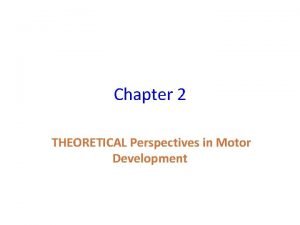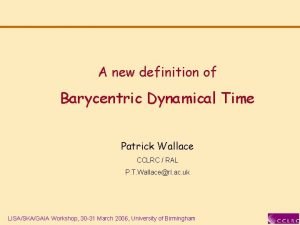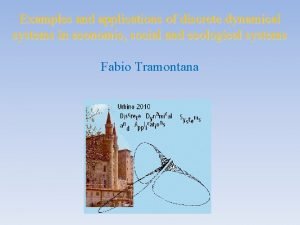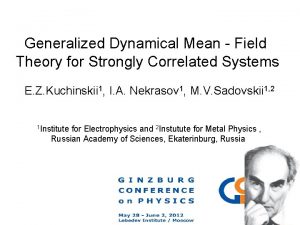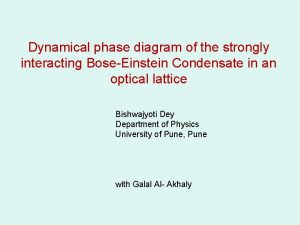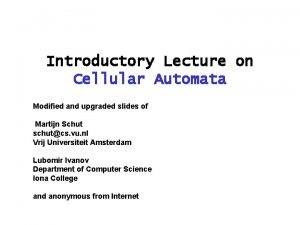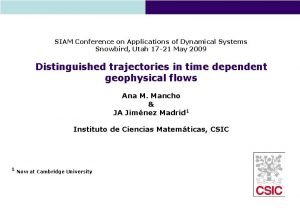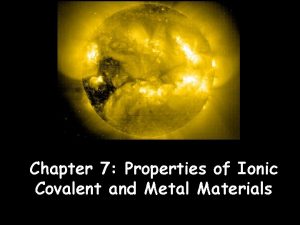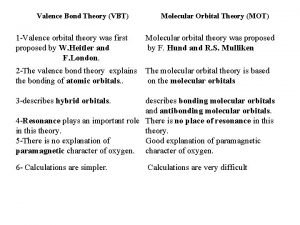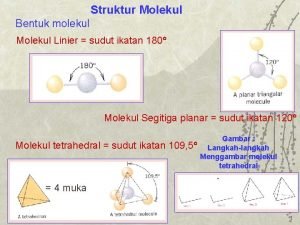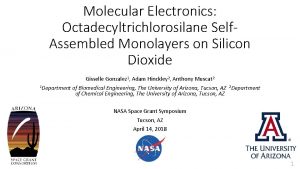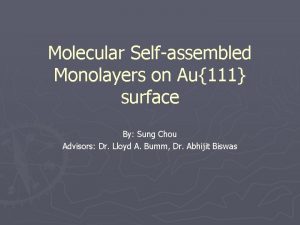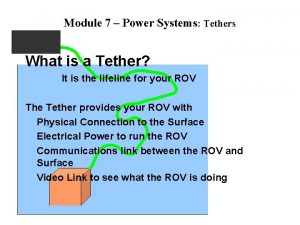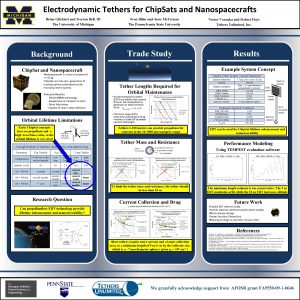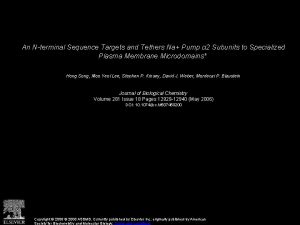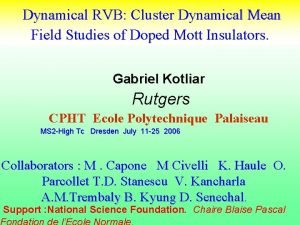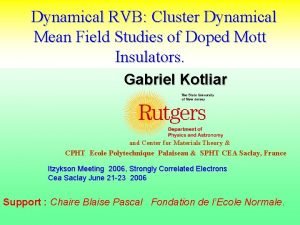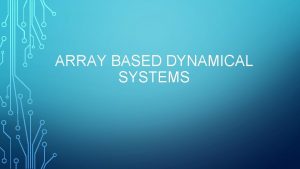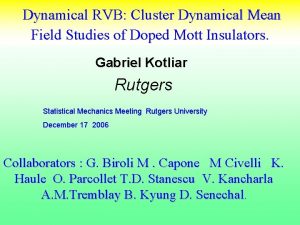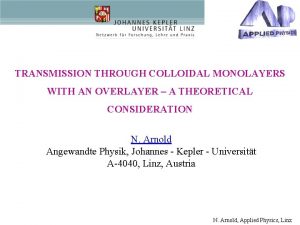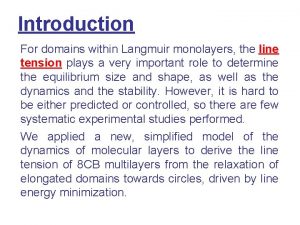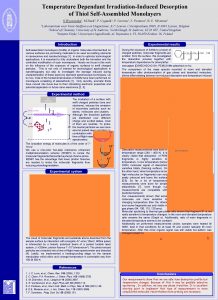A Dynamical Model of Molecular Monolayers Why Tethers



![Rayleigh Instability [1878] • Pure, cylindrical 3 D fluid • Varicose mode fluctuations • Rayleigh Instability [1878] • Pure, cylindrical 3 D fluid • Varicose mode fluctuations •](https://slidetodoc.com/presentation_image_h/3743089a2f1661198e7c5f8deee013a7/image-4.jpg)















- Slides: 19

A Dynamical Model of Molecular Monolayers: Why Tethers Don’t Snap? Lu Zou, * Violeta Beleva, * Andrew J. Bernoff, # James C. Alexander, + J. Adin Mann Jr. ! Elizabeth K. Mann* *Dept. of Physics, Kent State University # Dept. of Mathematics, Harvey Mudd College + Dept of Mathematics, Case Western Reserve University ! Dept of Chemical Engineering, Case Western Reserve University 1

Relaxation of 8 CB on Water/Air Interface Why Don’t Tethers Snap? 2

OVERVIEW • Introduction on Rayleigh instability (3 D) and Hele-Shaw flow (2 D) • A dynamic model of molecular monolayers (2 D) • Simulation and experimental results • Conclusion and prospects 3
![Rayleigh Instability 1878 Pure cylindrical 3 D fluid Varicose mode fluctuations Rayleigh Instability [1878] • Pure, cylindrical 3 D fluid • Varicose mode fluctuations •](https://slidetodoc.com/presentation_image_h/3743089a2f1661198e7c5f8deee013a7/image-4.jpg)
Rayleigh Instability [1878] • Pure, cylindrical 3 D fluid • Varicose mode fluctuations • Decrease area/surface energy • Break into droplets 4

Hele-Shaw Cell constrains Height of gap 5

Evolution of a long, narrow bubble Ref: Glasner, Karl A diffuse interface approach to Hele-Shaw flow NONLINEARITY 16 (1): 49 -66 JAN 2003 6

A dynamic model of molecular monolayers Z Ω Z=0 Subphase fluid Fundamental Hydrodynamic Equations • Stokes Equation • Continuity Equation 7

Assumptions on the subphase fluid • Horizontal flow • Boundary condition • Bulk viscosity ηbulk [Ref] Ref: Elizabeth K. Mann Hydrodynamics of Domain Relaxation in a Polymer Monolayer PRE 51 (6): 5708 -5720 JUN 1995 8

Assumptions on the surface • • 2 D Fluid (η and KG) One component [Ref 1]: – Elasticity KG [Ref 1]: Ω gas liquid – Surface pressure Π • • Surface Viscosities [Ref 2]: Electrostatic forces Ref 1: Ref 2: H. A. Stone; H. M. Mc. Connell; Proc. R. Soc. Lond. A 448: 97 -111 1995 9 Elizabeth K. Mann; PRE 51 (6): 5708 -5720 JUN 1995

Result on Small Distortion Limit For 2 D (n=2) L Ref: w H. A. Stone; H. M. Mc. Connell Hydrodynamics of quantized shape transitions of lipid domains Proc. R. Soc. Lond. A 448: 97 -111 1995 10

Lubrication Theory H(x, t) X Ref: L. Zhornitskaya; A. L. Bertozzi Positivity-preserving numerical schemes for lubrication-type equations 11 SIAM J. NUMER. ANAL. 37(2): 523 -555 2000

Simulation result Initial state: 12

Discussion on the Simulation • Periodic Boundary condition • No ends What constrains should be applied at the ends of the tether? 13

Hole Closing Poly(dimethyl)siloxane (PDMS) monolayer on water/air interface 14

Conclusion • A simplified model with assumptions close to the real experimental conditions Prospect • Line tension determination • Entire range of the relaxation behavior 15

Acknowledgement • Dr. Elizabeth K. Mann (Kent State University) • Dr. Andrew J. Bernoff (Harvey Mudd College) • Dr. James C. Alexander (Case Western Reserve University) • Dr. J. Adin Mann Jr. (Case Western Reserve University) • Ms. Violeta Beleva (Kent State University) • Ms. Ji Wang (Kent State University) • Supported by National Science Foundation under Grant No. 9984304 16

Frequent Questions • Brewster Angle Microscope (set-up) • Green Function Hele Shaw • F(n=2)=5 PI/16 (Stone); F(n=2)=5 PI/12 • Hole closing, linearly 17

Brewster Angle Microscope (set-up) CCD L 1 L 2 Ei A P B Water Surface 18

Hole Closing Linearly 19
 Pictures
Pictures Dynamical systems neuroscience
Dynamical systems neuroscience Dynamical systems theory motor development
Dynamical systems theory motor development Repeat
Repeat Discrete dynamical systems examples
Discrete dynamical systems examples Dynamical mean-field theory
Dynamical mean-field theory Solution in search of a problem
Solution in search of a problem Automata
Automata Siam conference on applications of dynamical systems
Siam conference on applications of dynamical systems Covalent bond boiling point
Covalent bond boiling point Ionic covalent metallic
Ionic covalent metallic Giant molecular structure vs simple molecular structure
Giant molecular structure vs simple molecular structure Don't ask why why why
Don't ask why why why Compound vs molecule
Compound vs molecule Mot and vbt
Mot and vbt Kinetic molecular theory
Kinetic molecular theory Sudut ikatan f2
Sudut ikatan f2 The basis of the vsepr model of molecular bonding is
The basis of the vsepr model of molecular bonding is Virtual molecular model kit
Virtual molecular model kit Components of service
Components of service


